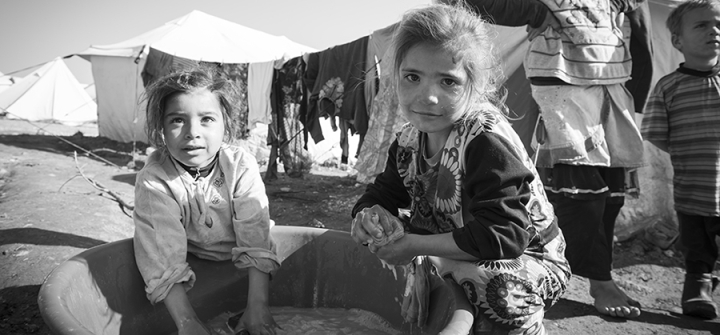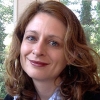Learn from the Pros: Public Health in Humanitarian Crises
Q&A with Course Creators Mija-Tesse Ververs and Gilbert Burnham
Noticing people in East Africa fishing with bednets intended to prevent malaria prompted Mija-Tesse Ververs, a public health expert specialized in humanitarian crises, to think about the need for all humanitarian responders to understand livelihood issues as well. If you can’t eat, the threat of disease can seem less pressing.
That emphasis on real-world examples informed the just-launched Public Health in Humanitarian Crises course, co-created by Ververs and Professor Gilbert Burnham, both with the Johns Hopkins Bloomberg School of Public Health Center for Humanitarian Health. This free online Coursera course builds on the Center’s 20 years of experience developing courses in humanitarian emergencies for graduate students and short courses for field practitioners. As the numbers of disasters stretched thin humanitarian resources it was clear, Burnham said, that a distance education approach was needed to build skills of responders who could not come to Baltimore. While it had been in the works for some time, Burnham credits Ververs with bringing the energy and the enthusiasm needed to pull it off.
Taught by instructors and guest lecturers with a combined 200+ years of experience in this field, the course involves about 11-15 hours of work that you can complete at your own pace. The course consists of 10 modules on topics ranging from health care and disease management, humanitarian coordination, water and sanitation to food security, nutrition, shelter and human rights. GHN’s Dayna Kerecman Myers reached out to co-creators Burnham and Ververs to learn more about this opportunity.
What do you hope people will learn from this short course?
The course aims to introduce an understanding of public health problems and the needs of people affected by conflict and disaster. This is an area which is becoming increasingly complex, and requires new skills. We hope to whet interest for possible humanitarians in the public health field and give them a great start.
We also want to provide a public service to anyone who seeks knowledge about the humanitarian health field. Understanding not only the technical issues but the political and cultural environment is critical to make sense of the humanitarian emergencies all around us. The course, provided by Coursera, is accessible to anyone, anywhere in the world, at any time, and is free—although if you would like to purchase a certificate upon completion, the cost is $49. We hope GHN readers will help us spread the word, especially to reach more people overseas—such as employees of local NGOs or governments—who could benefit.
Students will learn to identify risk groups in a disaster, to identify public health priorities in humanitarian crises, to differentiate between migrants, asylum seekers, refugees and internally displaced persons; and how to apply the principles of International Humanitarian Law.
Who do you think should take this course?
We’re seeking anyone interested in public health, with limited or no experience in humanitarian emergencies. We don’t aim to make people into experts, but to introduce them to the different public health problems experienced by people affected by natural disasters and/or conflict, and how to think through possible interventions.
You don’t need to have to hold a bachelor or master’s degree in a related field, but it might be particularly helpful for people interested in pursuing an MPH. Even with years of humanitarian experience, the public health approach is new to many people who would like to learn the basics. For example, an engineer or logistics expert might want to understand more about the connections between public health and camp design. Similarly, it’s important for doctors to learn about other aspects of emergencies, such as food security or protection issues. For complex emergencies, a multi-sectoral approach is key, as the course illustrates.
The modules could also be useful for instructors of other courses; we invite other professors to use our units in their teaching as well.
Was it difficult to design a course on such a sweeping topic for such a diverse audience?
Encompassing everything from sophisticated wars and conflict zones to drought and famine, humanitarian crises are diverse—and so the issues are diverse. We also want to reach people with very different backgrounds. That made it challenging at times to determine the appropriate degree of depth within the different modules, but ultimately, we’re convinced that there is something in this course for everyone. We also wanted to make the course inclusive for people with disabilities, or with limited access to technology; that prompted us to focus more on the substance of the content and less on flashy visuals.
How can those who sign up for the course get the most out of it?
We strongly encourage our learners to comment, join the discussions, and give us feedback on anything missing, or whether the level feels right.
Most importantly, while there is no fixed sequence and you aren’t required to complete every module, We urge people to explore the topics they don’t know as well yet. For example, if you think you’re seasoned in public health, look at other units like shelter and protection. Speaking from our own experience, coming from a medical/clinical perspective moving toward public health, we found learning more about shelter and livelihoods very valuable. You can focus on health, but people still need some of the basics—where they will work, where they will go to school. That’s livelihoods. Working in the field taught us that treatment protocols are futile if vulnerable people are missing other basics. If you ignore their priorities, you fail.
This interview has been edited for clarity and length.
Join the thousands of subscribers who rely on Global Health NOW summaries and exclusive articles for the latest public health news. Sign up for our free weekday enewsletter, and please share the link with friends and colleagues: Subscribe to GHN
Syrian girls wash clothes outside their tent in the displaced persons camp in Atmeh, Syria in 2013. Image by Joel Carillet/iStock





